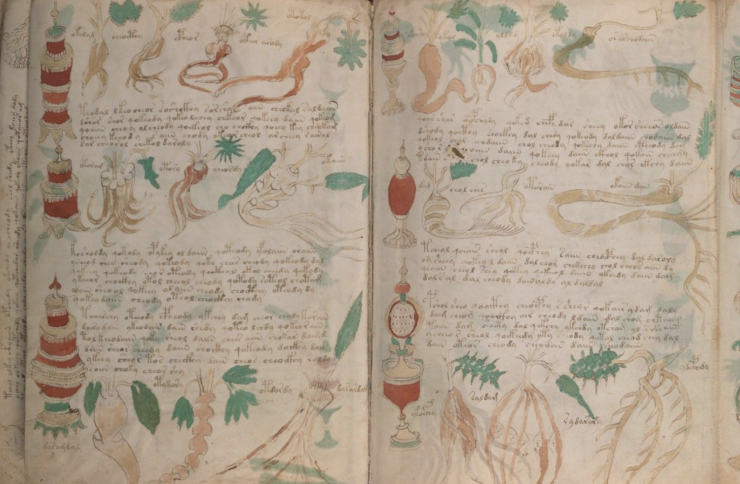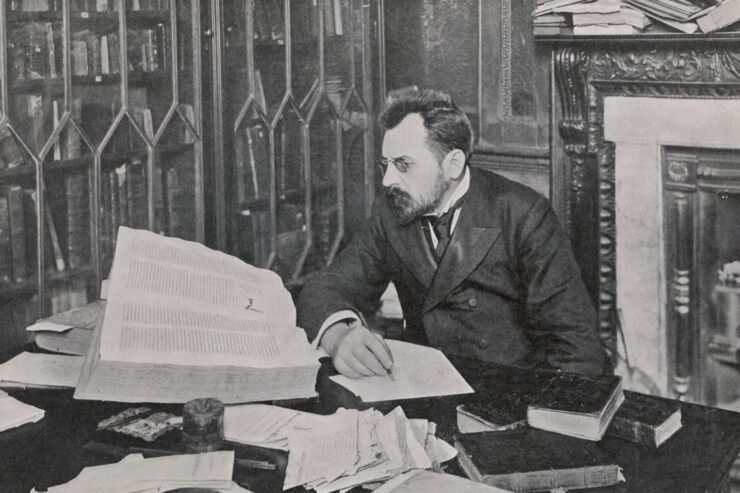As headlines have been informing us recently, censorship is very much alive and well across the United States—but there’s a difference between a book you’re not allowed to read and one you simply can’t read. The subset of non-censored reading material out there that actively seems to dare readers to make any sense of it is deep and vast. From codices to puzzles to straight-up art projects, books that aren’t meant to be read (or are essentially impossible to read) present the bibliophile with a true conundrum: Just how hard should you have to work to read and enjoy a book?
Here, then, are six publications that you’re free to try to track down, but which have a seriously select group of readers nonetheless…
Cain’s Jawbone by Edward Powys Mathers
Behold: One hundred pages, none of which are in order. If you want to read this book, you’re going to have to do a lot of guesswork—because there are 32 million possible combinations. As much a puzzle as a story, Cain’s Jawbone (first published in 1934 in The Torquemada Puzzle Book, “Torquemada” being Mathers’ pseudonym) is a murder mystery filled with red herrings, wandering sentences, references to books by Robert Louis Stevenson, puns, word games, and 18th-century French murder trials.
When first published, those who could solve the puzzle had the chance to win £15—but it wasn’t just about putting the pages in order. To pick up the cash you’d also have to explain who the six victims and their killers were. In 1935, two readers figured it out and claimed the prize—though the solution was never published. In 2019 the crowdfunded publisher Unbound collaborated with a charity, The Laurence Sterne Trust (whose namesake authored another famously unconventional work, Tristram Shandy) to publish a new edition and start the contest over. By the end of 2020 British comedian and crossword puzzle creator John Finnemore had solved the puzzle, noting in The Telegraph that being quarantined during the COVID-19 lockdown had given him the time he needed to focus on the task. He earned approximately £1,000—or the equivalent of £15 in 1934.
The Future Library
One reason you can’t read the books in the Future Library is that some of them haven’t been written yet. Another reason is that even the solicited submissions are being locked away in the “Silent Room” of Oslo, Norway’s public library. And a further one is that the trees that will provide the paper for the books to be printed on are still growing.
The Future Library project is a 100-year art project conceived by Scottish artist Katie Paterson and commissioned by Norwegian Anne Beate Hovind (along with some trustees), and is designed to give humans a greater sense of the expanse of time. Each year since 2014, one well-known writer has been invited to submit an original manuscript, a process that will continue until 2113. None of the manuscripts will be published before then, and all are being stored away in the Silent Room’s locked glass drawers. Meanwhile, the spruces from which the paper will be harvested have been planted in a forest north of Oslo and are set to spend the next hundred years growing. Authors who have submitted manuscripts so far include Margaret Atwood, David Mitchell, Sjón, Elif Shafak, Han Kang, and Ocean Vuong.
The Voynich Manuscript

Technically, the Voynich Manuscript is readable. There are words, and there are even pictures. But that doesn’t mean anybody’s ever been able to read it. Radiocarbon dated to the 15th century (it’s printed on calfskin parchment), the 225-page codex is named after the Polish-American bookseller Wilfrid M. Voynich, who came into possession of the text in 1912. It’s a beautifully-rendered, totally incomprehensible collection of drawings, plus words in a language no one yet has been able to decipher. Reminiscent of a scientific notebook, the contents (available to view thanks to Yale Library’s digitization) can be divided into six areas: botanicals (including drawings of over 110 unidentified plants); astronomical/astrological drawings; cosmological medallions; pharmaceutical sketches of over 100 herbs and roots in jars; text (some of which may be recipes); and biological drawings—mostly of nude or pregnant women. It has the feeling of a journal left behind by an extra-terrestrial who’d taken careful notes, then vanished—but some insist it’s just a hoax.
20 Slices of American Cheese by Ben Denzer
Cheese lovers will melt for this book. Square and yellow, just like its contents, 20 Slices… is exactly what its title suggests: twenty pieces of sliced, individually-wrapped Kraft cheese surrounded by a hardback book cover. Since Kraft slices are shelf-stable, they won’t go bad very fast—which has allowed this book to be shelved in libraries around the world (including the University of Oxford), though usually in a plastic container. Created by book artist and designer Ben Denzer, he published it through his Catalog Press in 2018, and it now follows in line with some of his other 20-themed “books”—he’s also “published” 20 Slices of Meat, 200 Fortunes, and 5 Ketchups (which were, for a time, available at the Whitney Museum’s gift shop).
ONEPIECE by Ilan Manouach
Got some time? Then you might want to dive into One Piece, the incredibly popular manga series written and illustrated by Eiichiro Oda, which has been serialized in the Japanese magazine Weekly Shōnen Jump each week since 1997. It’s the best-selling manga series ever, with over 516.6 million copies in print as of August 2022, and has been adapted into an animated series with more than 1,000 episodes. But the book version that encompasses all of the various volumes of One Piece exists in the form of a 21,450-page collection put together by artist Manouach. He printed out digital pages from the manga, then compiled them into a single volume that literally cannot be read without breaking the entire piece. Only fifty copies were made, and cost approximately $2,000 each (and they’ve sold out). So how is this not some kind of major copyright issue? As the French publisher JBE told The Guardian, ONEPIECE is not really a book—it’s “sculptural material,” and is not meant to be read.
Finnegans Wake, by James Joyce
Okay, slow your roll, Joyceans: Certainly, it’s easy enough to sit down with a copy of Finnegans Wake. Of all the books listed here, Joyce’s 1939 stream-of-consciousness experimental masterpiece is clearly the most accessible. That’s not the same as saying it’s comprehensible. Joyce’s language includes a lot of made-up constructions, portmanteaus, dream imagery, and super-long sentences, which make it a book you either need to concentrate on, or ideally, hear read aloud. (And once you finish, you can start all over again; the final sentence of the book links to the first, making the book one big circle.)
What’s it about? Well, it’s probably simplest to say that it’s about the Earwicker family, whose patriarch is under attack and whose children are trying to usurp him. Some find it very funny; some have compared it to Dante and Shakespeare. Of course, Joyce is hardly the only author to write seriously dense, meandering novels that are as much about the experience as the comprehension or interpretation—just look at the works of David Foster Wallace (Infinite Jest), William Faulkner (The Sound and the Fury), Russell Hoban (Riddley Walker), and Thomas Pynchon (Gravity’s Rainbow). You might make it to the end, but that doesn’t mean you’ll ever fully understand all their layers of meaning—they’re books that don’t make the price of admission easy, but they do make the journey something special.
Randee Dawn is the author of the funny, fantastical pop culture novel Tune in Tomorrow, which was a finalist in the 2023 Next Generation Indie Awards. She’s also the co-editor of The Law & Order: SVU Unofficial Companion and co-edited the anthology Across the Universe: Tales of Alternative Beatles. An entertainment journalist who writes for The Los Angeles Times, Variety, Today.com, and many other publications, Randee is working on her follow-up to Tune in Tomorrow and lives in Brooklyn with her spouse and a fluffy, sleepy Westie.










